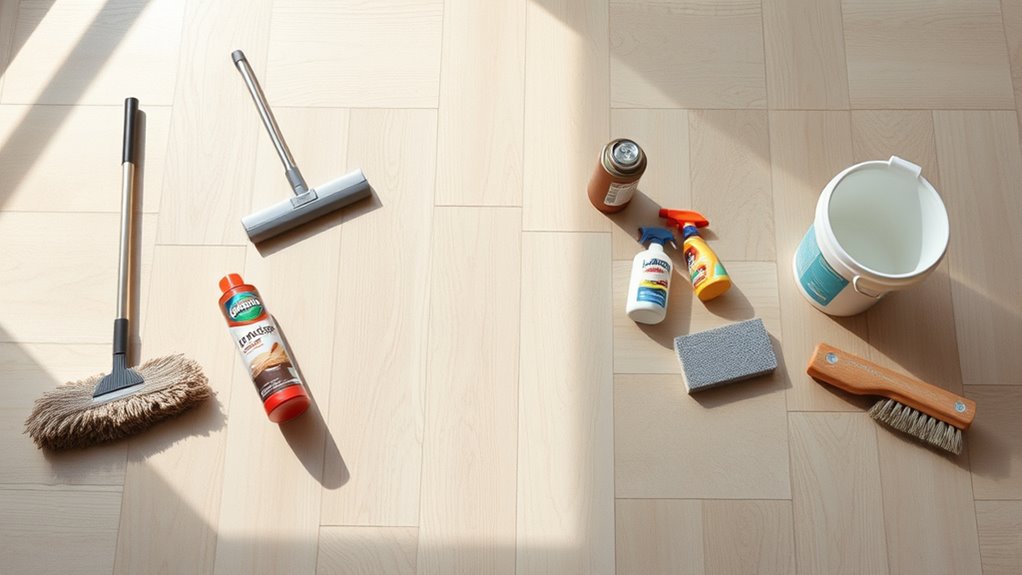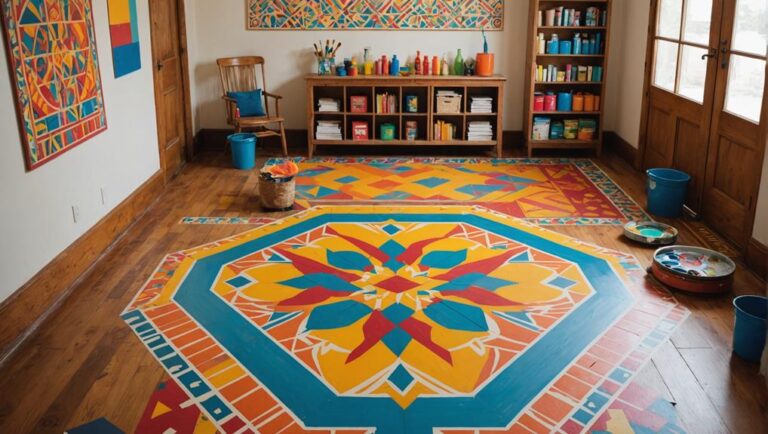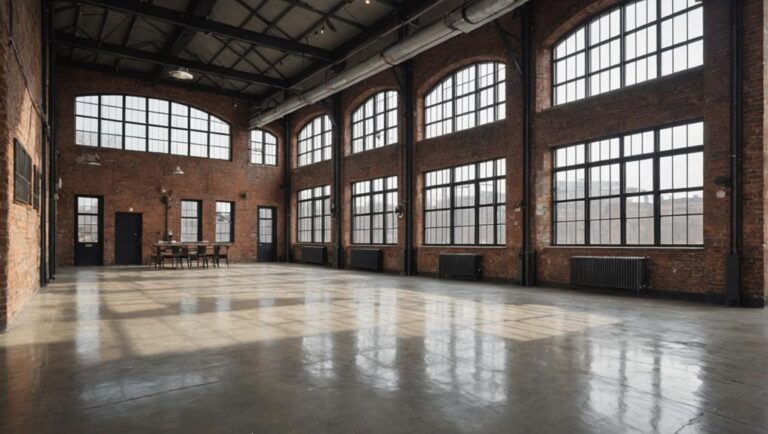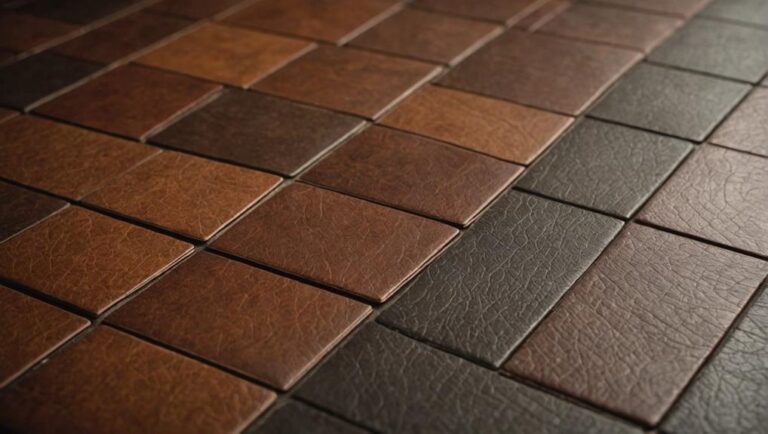You shouldn’t use abrasive cleaners on laminate floors since they scratch and damage the surface permanently. Avoid wax, polish, and oil-based soaps as they leave slippery, dull residues that attract dirt. Steam cleaners and excessive water can cause swelling and warping. Harsh chemicals like bleach and ammonia erode the protective layer, leading to discoloration. Also, steer clear of rough mops or stiff brushes which scratch the finish. Keep these in mind, and you’ll better preserve your floor’s durability and appearance while exploring safer cleaning options.
Abrasive Cleaners
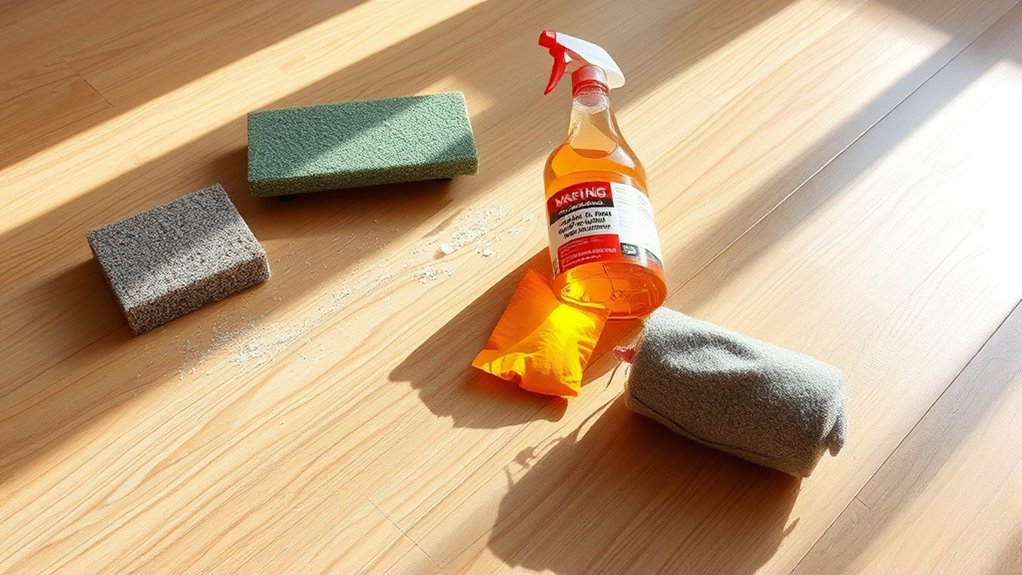
When cleaning laminate floors, you should avoid abrasive cleaners because they can scratch and damage the surface. These harsh substances create micro-scratches that degrade the floor’s protective layer, reducing its lifespan and aesthetic appeal. Instead, focus on non abrasive alternatives such as pH-neutral cleaners or specially formulated laminate floor solutions. Employing proper cleaning techniques—including using a soft microfiber mop and minimal water—prevents excess moisture infiltration, which can also harm the floor. Avoid scrubbing with steel wool, scouring pads, or gritty powders; these tools exacerbate surface wear. By selecting gentle, effective products and following recommended procedures, you guarantee your laminate floors remain pristine and durable. This approach grants you the freedom to maintain your flooring with confidence, preserving both function and beauty over time.
Wax or Polish
You shouldn’t apply wax or polish to laminate floors because they create a slippery surface that increases the risk of falls. These products also leave a residue buildup that can dull the floor’s finish and attract dirt. Instead, use cleaners specifically designed for laminate to maintain safety and appearance.
Causes Slippery Surface
Although laminate floors are designed to resist moisture and wear, applying wax or polish can create a slippery surface that compromises safety. This slippery effect increases the risk of falls and injuries, undermining slip prevention efforts. Wax and polish form a glossy layer that reduces traction, making your floors hazardous, especially in high-traffic areas.
| Product Type | Effect on Laminate | Safety Impact |
|---|---|---|
| Wax | Glossy, slippery | High slip risk |
| Polish | Seals surface | Reduced friction |
| Safe Alternatives | Maintain texture | Enhance slip prevention |
To maintain your freedom of movement and safety, avoid wax and polish. Opt instead for safe alternatives like pH-neutral cleaners that preserve traction without compromising laminate integrity.
Leaves Residue Buildup
Residue buildup from wax or polish can greatly impair the appearance and performance of laminate floors. When you apply these substances, they often leave behind a film that attracts dirt and grime, leading to visible residue effects. This buildup dulls the floor’s finish and can cause uneven wear, reducing the floor’s lifespan. Since laminate floors have a protective wear layer, waxing or polishing is unnecessary and counterproductive. To maintain your floor’s freedom from residue, rely on proper cleaning techniques: use a damp microfiber mop with a pH-neutral cleaner specifically designed for laminate. Avoid excessive moisture, and never apply wax or polish. By understanding these residue effects and adopting correct cleaning methods, you guarantee your laminate floors stay clean, vibrant, and durable without unwanted buildup.
Steam Cleaners
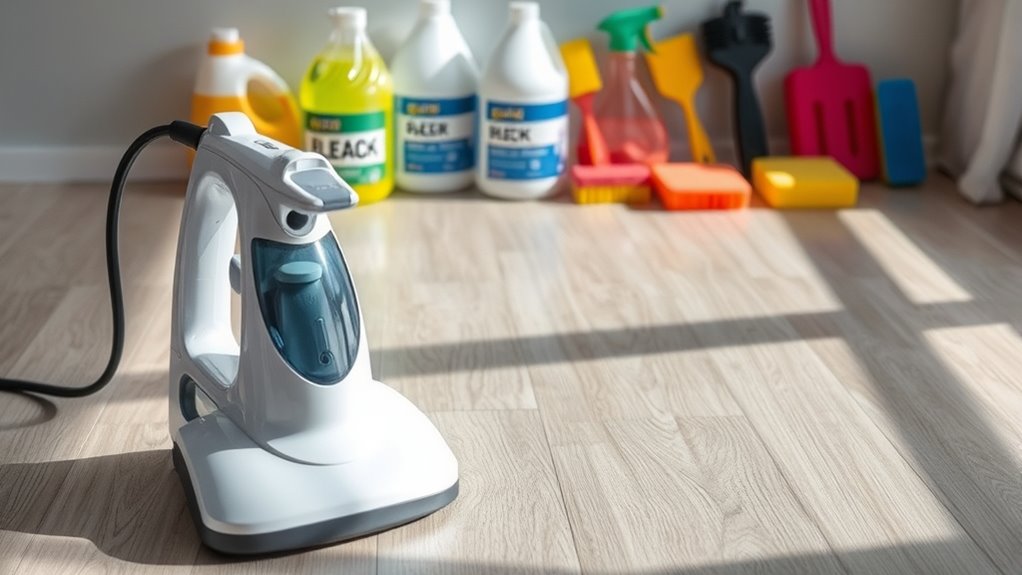
When using steam cleaners on laminate floors, you need to be cautious about excess moisture, which can seep into seams and cause swelling or warping. The high heat and steam pressure may also damage the surface finish, leading to dullness or peeling. Understanding these risks helps you choose the safest cleaning method for your laminate flooring.
Excess Moisture Risks
Because laminate floors are sensitive to water, using steam cleaners can introduce excess moisture that may cause warping, swelling, or delamination. When you rely on steam, the high humidity penetrates the laminate layers, compromising the integrity of the core material. Proper moisture control is critical to preserving your floor’s structure and appearance. Unlike hardwood, laminate isn’t designed to absorb water; too much moisture disrupts the adhesive bonds between layers. For effective floor maintenance, avoid steam or any wet cleaning methods that leave lingering dampness. Instead, use slightly damp microfiber mops or dry cleaning techniques to maintain cleanliness without risking damage. Prioritizing moisture control guarantees your laminate floor remains durable and visually appealing, giving you the freedom to enjoy your space without constant worry about costly repairs.
Potential Surface Damage
Although steam cleaners promise efficient cleaning, they can cause significant surface damage to laminate floors. The high heat and moisture from steam penetrate laminate’s protective layer, leading to surface discoloration and warping. This compromises the floor’s integrity and voids many manufacturer warranties. Additionally, the pressure and abrasive steam nozzle may create micro-scratches, undermining scratch prevention measures integrated into the laminate’s finish. If you value your floor’s appearance and longevity, avoid steam cleaning altogether. Instead, opt for damp mopping with a well-wrung microfiber cloth to maintain surface protection while removing dirt effectively. By steering clear of steam cleaners, you preserve both the aesthetic and structural qualities of your laminate flooring, ensuring it remains durable and visually appealing over time.
Ammonia-Based Products
If you choose to use ammonia-based products on laminate floors, it’s important to proceed with caution since ammonia can affect the floor’s finish. These harsh chemicals can strip protective coatings, causing dullness and potential damage over time. Instead, look for ammonia alternatives among cleaning solutions specifically formulated for laminate surfaces.
Using ammonia-based cleaners can:
- Erode the wear layer, reducing durability.
- Cause discoloration, compromising aesthetics.
- Leave residues that attract dirt, increasing maintenance.
- Expose you to strong fumes, limiting safe usage freedom.
To maintain your laminate floor’s integrity and your freedom to enjoy a clean, safe home environment, opt for gentle, ammonia-free cleaning solutions. This approach preserves both the surface and your peace of mind.
Excessive Water
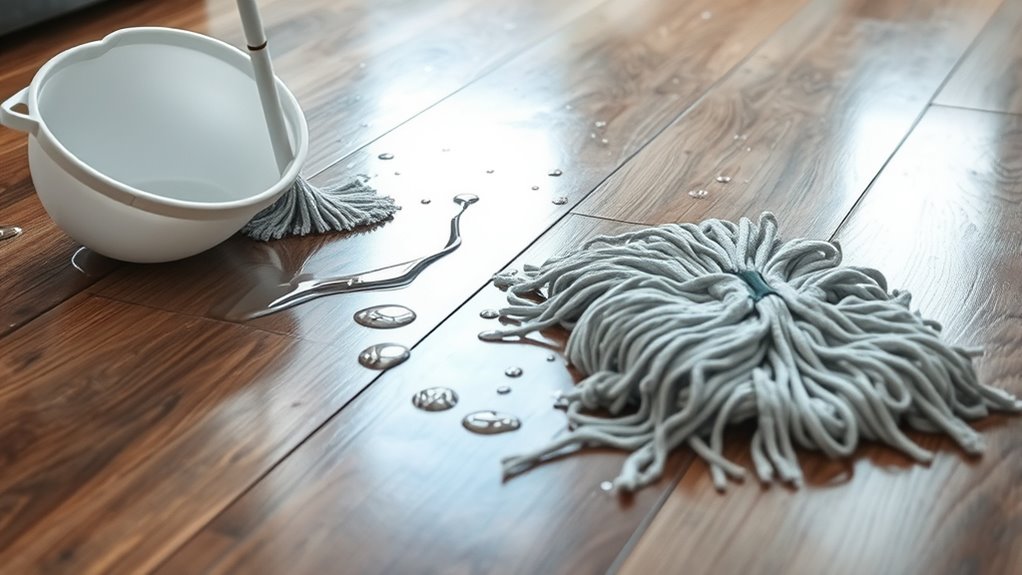
While laminate floors are designed to resist moisture better than hardwood, excessive water can still penetrate seams and cause swelling, warping, or delamination. You want to minimize water absorption to maintain the integrity of your laminate flooring. For ideal laminate maintenance, avoid soaking floors and use damp, not wet, cleaning tools.
| Risk Factor | Effect on Laminate | Recommended Action |
|---|---|---|
| Excessive Water | Seams swell, warping | Use a damp mop, avoid puddles |
| Prolonged Exposure | Delamination and damage | Wipe spills immediately |
| Improper Drying | Mold and discoloration | Guarantee thorough drying |
Controlling water exposure is essential for preserving your laminate’s durability and appearance.
Oil-Based Soaps
One common mistake you can make when cleaning laminate floors is using oil-based soaps, which can leave a residue that dulls the finish and attracts dirt. This oil residue builds up over time, making your floor look grimy and worn. To keep your floors pristine and maintain your freedom to enjoy a clean space, avoid these pitfalls:
Using oil-based soaps on laminate floors leaves a dull residue that attracts dirt and wears down the finish.
- Expecting oil-based soaps to enhance shine—they actually cause dullness.
- Ignoring the sticky film that traps dust and grime, increasing cleaning frequency.
- Using harsh scrubbing to remove residue, which risks damaging the laminate surface.
- Overlooking effective cleaning alternatives specifically designed for laminate floors, like pH-neutral cleaners.
Choose cleaning alternatives that protect the finish and preserve your floor’s durability without compromising your freedom from constant upkeep.
Bleach or Harsh Chemicals
Using bleach or harsh chemicals on laminate floors can cause irreversible damage to the surface layer, compromising both appearance and durability. These substances break down the protective topcoat, leading to discoloration, warping, and accelerated wear. Instead, you should opt for bleach alternatives specifically designed for laminate surfaces, which maintain chemical safety while effectively cleaning. Avoid products with strong acids, ammonia, or abrasive agents, as they disrupt the floor’s integrity. Maintaining chemical safety not only preserves your floor’s finish but also protects your indoor air quality and your health. By choosing gentle, pH-balanced cleaners, you retain the freedom to keep your floors spotless without risking costly repairs or replacements. Always follow manufacturer guidelines and test any new cleaner in an inconspicuous area first.

